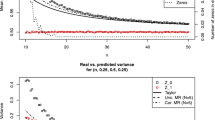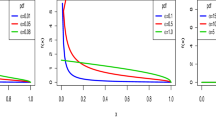Abstract
The Conway–Maxwell–Poisson distribution is a two-parameter generalization of the Poisson distribution that can be used to model data that are under- or over-dispersed relative to the Poisson distribution. The normalizing constant \(Z(\lambda ,\nu )\) is given by an infinite series that in general has no closed form, although several papers have derived approximations for this sum. In this work, we start by using probabilistic argument to obtain the leading term in the asymptotic expansion of \(Z(\lambda ,\nu )\) in the limit \(\lambda \rightarrow \infty \) that holds for all \(\nu >0\). We then use an integral representation to obtain the entire asymptotic series and give explicit formulas for the first eight coefficients. We apply this asymptotic series to obtain approximations for the mean, variance, cumulants, skewness, excess kurtosis and raw moments of CMP random variables. Numerical results confirm that these correction terms yield more accurate estimates than those obtained using just the leading-order term.
Similar content being viewed by others
References
Boatwright, P., Borle, S., Kadane, J. B. (2003). A model of the joint distribution of purchase quantity and timing. Journal of the American Statistical Association, 98, 564–572.
Conway, R. W., Maxwell, W. L. (1962). A queueing model with state dependent service rate. Journal of Industrial Engineering, 12, 132–136.
Daly, F., Gaunt, R. E. (2016). The Conway–Maxwell–Poisson distribution: Distributional theory and approximation. ALEA: Latin American Journal of Probability and Mathematical Statistics, 13, 635–658.
Gaunt, R. E. (2015). Stein’s method for functions of multivariate normal random variables. arXiv:1507.08688.
Gillispie, S. B., Green, C. G. (2015). Approximating the Conway–Maxwell–Poisson distribution normalizing constant. Statistics, 49, 1062–1073.
Hazelwinkel, M. (1997). Encyclopedia of mathematics, Supplement I. Dordrehct: Kluwer Academic Publishers.
Hinch, E. J. (1991). Perturbation methods. Cambridge: Cambridge University Press.
Kadane, J. B., Shmueli, G., Minka, T. P., Borle, S., Boatwright, P. (2006). Conjugate analysis of the Conway–Maxwell–Poisson distribution. Bayesian Analysis, 1, 403–420.
Lin, Y., Wong, R. (2017). Asymptotics of generalized hypergeometric functions. Frontiers of orthogonal polynomials and q-series. Singapore: World Scientific. (preprint).
Nadarajah, S. (2009). Useful moment and CDF formulations for the COM-Poisson distribution. Statistical Papers, 50, 617–622.
NIST Digital Library of Mathematical Functions. (2016). Olver, F. W. J., Olde Daalhuis, A. B., Lozier, D. W., Schneider, B. I., Boisvert, R. F., Clark, C. W., Miller, B. R., Saunders, B. V. (eds.). http://dlmf.nist.gov/. Release 1.0.12 of 2016-09-09.
Olver, F. W. J. (1974). Asymptotics and special functions. New York: Academic Press.
Paris, R. B., Kaminski, D. (2001). Asymptotics and Mellin–Barnes integrals. Cambridge: Cambridge University Press.
Pogány, T. K. (2016). Integral form of the COM-Poisson renormalization constant. Statistics and Probability Letters, 116, 144–145.
Rodrigues, J., de Castro, M., Cancho, V. G., Balakrishnan, N. (2009). COM-Poisson cure rate survival models and an application to a cutaneous melanoma data. Journal of Statistical Planning and Inference, 139, 3605–3611.
Sellers, K. F., Shmueli, G. (2010). A flexible regression model for count data. Annals of Applied Statistics, 4, 943–961.
Sellers, K. F., Borle, S., Shmueli, G. (2012). The COM-Poisson model for count data: A survey of methods and applications. Applied Stochastic Models in Business and Industry, 28, 104–116.
Shmueli, G., Minka, T. P., Kadane, J. B., Borle, S., Boatwright, P. (2005). A useful distribution for fitting discrete data: Revival of the COM-Poisson. Journal of the Royal Statistical Society: Series C, 54, 127–142.
Şimşek, B., Iyengar, S. (2016). Approximating the Conway–Maxwell–Poisson normalizing constant. Filomat, 30, 953–960.
Stein, C. (1986). Approximate computation of expectations. Hayward, California: IMS.
Weniger, E. J. (2010). Summation of divergent power series by means of factorial series. Applied Numerical Mathematics, 60, 1429–1441.
Acknowledgements
RG is supported by a Dame Kathleen Ollerenshaw Research Fellowship. SI is supported by a grant from the National Institute of Mental Health (5R01 MH060952-09). AOD is supported by a research grant (GRANT 11863412/70NANB15H221) from the National Institute of Standards and Technology. The authors would like to thank the referees for their helpful comments and suggestions.
Author information
Authors and Affiliations
Corresponding author
Further proofs
Further proofs
1.1 Proof of Theorem 1
The generalized hypergeometric function is defined by
provided none of the \(b_j\) are nonpositive integers, where the Pochhammer symbol is \((a)_0=1\) and \((a)_n=a(a+1)(a+2)\cdots (a+n-1)\), \(n\ge 1\). In the case that \(p\le q\) the infinite series converges for all finite values of z and defines an entire function. For more details see §16.2 in the NIST Library (2016). As noted by Nadarajah (2009), \(Z(\lambda ,\nu )=_0F_{\nu -1}(;1,\ldots ,1;\lambda )\) for integer \(\nu \). Thus, we can exploit the well-developed theory for asymptotics of the generalized hypergeometric function to obtained an asymptotic expansion for \(Z(\lambda ,\nu )\) when \(\nu \) is an integer. Indeed, 16.11.9 in the NIST Library (2016) can be used to write down the entire expansion for integer \(\nu \). However, this expansion is only valid for integer \(\nu \), and, since \(b_1=\cdots =b_{\nu -1}=1\), the coefficients of the lower-order terms in the expansion must be obtained via a tedious limiting procedure. We can, however, make use of a recent work on the asymptotics of the generalized hypergeometric function to prove Theorem 1.
Proof of Theorem 1
We obtain the expansion (4) by appealing to results from the recent work of Lin and Wong (2017), in which the large z asymptotics of the generalized hypergeometric function \({}_pF_q\left( \begin{array}{c} a_1,\cdots ,a_p\\ b_1,\cdots ,b_q \end{array};z\right) \) are discussed. Here we will have \(p=0\), all the \(b_k=1\) and \(q=\nu -1\). In the proof of Lemma 4.3 in Lin and Wong (2009) it is not essential that q is a nonnegative integer and below we copy the main steps.
Lin and Wong (2017) used as their starting point the integral representation 16.5.1 in the NIST Library (2016) of the generalized hypergeometric function. As mentioned in the introduction, the integral representation (3) is just a simple generalization of 16.5.1 in the NIST Library (2016). We rewrite it as
and use the inverse factorial expansion (again, see Lin and Wong (2017), or §2.2.2 in Paris and Kaminski (2001), and for more information about factorial series see Weniger (2010))
in the integral in (29) and combine this with the proof of Lemma 4.3 in Lin and Wong (2017). The result is asymptotic expansion (4).
To compute the \(c_j\) we substitute the Stirling approximation
(see 5.11.3 in the NIST Library (2016) into both sides of (30). Here \(g_0=1\), \(g_1=\frac{1}{12}\), \(g_2=\frac{1}{288}\), and further values are given in 5.11.4 – 5.11.6 in the NIST Library (2016). In this way we obtain large t asymptotic expansions for both sides of (30) and we can compare the coefficients to find the \(c_j\). Computer algebra is very useful for this process; we used Maple to obtain the first eight coefficients. The result is:
\(\square \)
1.2 Proof of Lemma 2
Let us first note two results that were derived using Stein’s method. Theorem 6 is proved in Stein (1986), whilst Theorem 7 is a special (and slightly simplified) case of the general bound of Theorem 3.5 of Gaunt (2015). The simplified bound is, however, sufficiently tight for the purpose of proving part (ii) of Lemma 2.
Theorem 6
Stein (1986). Let \(X_1,\ldots ,X_n\) be i.i.d. random variables with \({\mathbb {E}}X_1=0\), \({\mathbb {E}}X_1^2=1\) and \({\mathbb {E}}|X_1|^3<\infty \). Set \(W=\frac{1}{\sqrt{n}}\sum _{i=1}^nX_i\) and let \(Z\sim N(0,1)\). Suppose \(h:{\mathbb {R}}\rightarrow {\mathbb {R}}\) has a bounded first derivative on \({\mathbb {R}}\). Then
where \(\Vert h'\Vert _\infty =\sup _{x\in {\mathbb {R}}}|h'(x)|\).
Theorem 7
Gaunt (2015). Let \(X_1,\ldots ,X_n\) and W be defined as in Theorem 6, but with the additional assumption that \({\mathbb {E}}|X_1|^6<\infty \). Suppose \(h:{\mathbb {R}}\rightarrow {\mathbb {R}}\) is an even function and is twice differentiable with first and second derivative bounded on \({\mathbb {R}}\). Then there exists a constant C independent of n such that
Proof of Lemma 2
Let \(X_\alpha \sim {\mathrm {Po}}(\alpha )\) and set \(\tilde{X_\alpha }=\frac{X_\alpha -\alpha }{\sqrt{\alpha }}\). We shall suppose \(\alpha \ge 1\) (later we shall let \(\alpha \rightarrow \infty \)). Also, let \(Y_1,\ldots ,Y_{\lfloor \alpha \rfloor }\) be i.i.d. random variables following the \({\mathrm {Po}}\Big (\frac{\alpha }{\lfloor \alpha \rfloor }\Big )\) distribution, where the floor function \(\lfloor x\rfloor \) is the greatest integer less than or equal to x. Then, by a standard result, \(\sum _{i=1}^{\lfloor \alpha \rfloor }Y_i\sim {\mathrm {Po}}(\alpha )\), and so is equal in distribution to \(X_\alpha \). Therefore \(\tilde{X_\alpha }{\mathop {=}\limits ^{\mathcal {D}}}\frac{1}{\sqrt{\alpha }}\big (\sum _{i=1}^{\lfloor \alpha \rfloor }Y_i-\alpha \big )\). In order to apply Theorems 6 and 7, we note that
where
The random variables \(\tilde{Y}_1,\ldots ,\tilde{Y}_n\) are i.i.d. with \({\mathbb {E}}\tilde{Y}_1=0\) and \({\mathbb {E}}\tilde{Y}_1^2=1\). The absolute moments of \(\tilde{Y}_1\) up to sixth order are also finite and are \({\mathcal {O}}(1)\) as \(\alpha \rightarrow \infty \). Parts (i) and (ii) of the lemma (for which different assumptions are made on the function h) now follow from applying Theorems 6 and 7 to bound the quantity \(|{\mathbb {E}}[h(\tilde{X_\alpha })]-{\mathbb {E}}[h(Z)]|\) and noticing that the resulting bounds are of order \({\mathcal {O}}(\alpha ^{-1/2})\) and \({\mathcal {O}}(\alpha ^{-1})\), respectively, as \(\alpha \rightarrow \infty \). \(\square \)
About this article
Cite this article
Gaunt, R.E., Iyengar, S., Olde Daalhuis, A.B. et al. An asymptotic expansion for the normalizing constant of the Conway–Maxwell–Poisson distribution. Ann Inst Stat Math 71, 163–180 (2019). https://doi.org/10.1007/s10463-017-0629-6
Received:
Revised:
Published:
Issue Date:
DOI: https://doi.org/10.1007/s10463-017-0629-6




